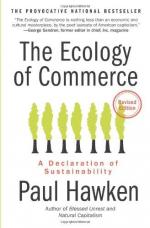|
This section contains 355 words (approx. 1 page at 400 words per page) |

|
Chapter 11, Pink Salmon and Green Fees Summary and Analysis
Economists and ecologists differ on their measure of efficiency. Economists measure efficiency in terms of dollars or money. Ecologists measure efficiency in terms of thermodynamics and resource conservation. There are still areas of agreement between the two groups. Whenever there is waste, there are higher costs. A reduction in inefficiency means lower costs and therefore less waste. According to Hawken, "Because efficiency should be the common ground between economics and ecology, it represents the bridge to a restorative economy" (Chapter 11, pg. 179). The purpose of energy taxes is to lower the carbon dioxide levels. This is in response to fears about global warming. The purpose of green taxes is to increase the costs high enough to stop the damage. Solar energy is cleaner than the carbon dioxide forms of energy and does...
(read more from the Chapter 11, Pink Salmon and Green Fees Summary)
|
This section contains 355 words (approx. 1 page at 400 words per page) |

|




